Introduction:
Internet of Things is now a reality, and IoT application developers struggle for tech advancements to get going fast in IoT app development. To ease developers and others involved in the industry, some innovations are made regularly, and Cloud IoT Core service is one. Let’s see how it is. Today we already have technologies to connect the device to the cloud. Still, IoT Core is an advanced approach that eliminates the process of using a gateway or another platform to forward IoT data. IoT Core avoids additional layers for the deployment process and adds enhanced security features to funnel a huge amount of IoT sensor data to the cloud for monitoring, processing, analysis, and visualizing automatically. In due course, Google has recently unveiled its Google Cloud IoT Core services opening its account though late, but with advanced services to beat its competitors like Amazon Cloud and Microsoft Azure.Cloud IoT Core Platforms
In the field of cloud IoT Core services, Google has associated platforms and services with aiding such as,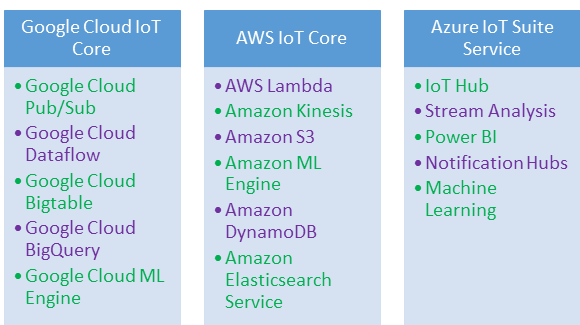
- Cloud Pub/Sub
- Google Cloud Dataflow
- Google Cloud Bigtable
- Google BigQuery
- Google Cloud Machine Learning Engine
- AWS Lambda
- Amazon Kinesis
- Amazon S3
- Amazon Machine Learning
- Amazon DynamoDB
- Amazon Elasticsearch Service with Kibana integration
- IoT Hub (A SaaS Solution)
- Notification Hub
- Stream Analysis
- Power BI
- Machine Learning
Key Concepts of Google Cloud IoT Core
It is easy to understand Google Cloud IoT Core if you follow the following key concepts.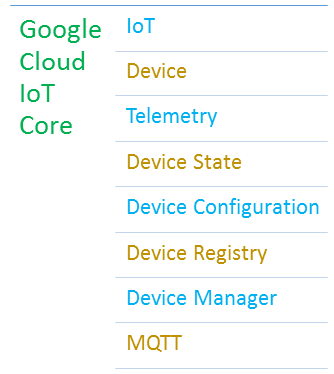
Internet of Things:
Physical objects (living and non-living) connected with the Internet or any network capable of automatically exchanging data and executing the inferred commands.Device:
It is called ‘Thing’ in the term Internet of Things. It is a kind of processing unit with the power to connect attached sensors with the world of the Internet like server or cloud services and exchange two kinds of data, ‘Telemetry’ and ‘State’ among the network of connected devices and centralized processing units.Telemetry:
It consisted of all types of ‘Event Data’ sent from sensors-devices-connectivity modes to cloud/servers on the Internet and termed as ‘Device Telemetry Event’ data. Google Cloud Big Data Solutions is an excellent choice for analyzing telemetry data. Various weather parameters in environment data collected by different sensors is an ideal example of telemetry data.Device State:
It is a user-defined blob of arbitrary data describing the device’s current status and flows from the device to cloud direction. It could be structured or unstructured data.Device Configuration:
Device configuration is used to control device state and similar to device state data in properties.Device Registry:
It is a container of devices and has shared properties, so after registration of devices on Cloud IoT Core; you can manage it through the device manager.Device Manager:
It monitors the health of devices, activities, updating device configuration, and managing credentials and authentication. Check it out : Top 8 IoT App Trends to reign in 2020MQTT:
Message Queue Telemetry Transport (MQTT) is a standard IoT protocol to publish or subscribe (Pub/Sub) messaging protocol just like HTTP.Components of Google Cloud IoT Core
There are two main components of Cloud IoT Core services. The first is Device Manager, and another is Protocol Bridge.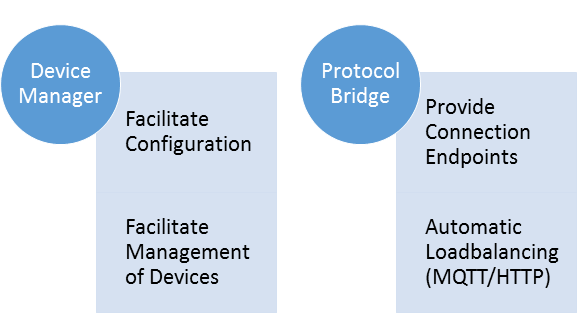
Device Manager:
- It allows configuration of the individual
- It will enable us to monitor & manage it securely.
- It uses the console for management or goes programmatically.
- The role of the device manager is to establish the identity of the device and provide an authentication mechanism when it is
- It maintains the logical configuration of the device and remotely controls the device from the cloud.
Protocol Bridge:
- It provides connection endpoints for protocols.
- There are two protocols used in Protocol Bridge, MQTT & HTTP.
- Protocols come with automatic load balancing capacities for all connections of devices.
- It has support for secure connections through the latest security technologies and tools.
- The role of Protocol Bridge is to publish device telemetry to Cloud Pub/Sub.
- It may consume by the downstream analytic system.
Features of Google Cloud IoT Core
Google Cloud IoT Core comes with some distinctive features that keep it apart from the rests of its rivals in the market, and those are: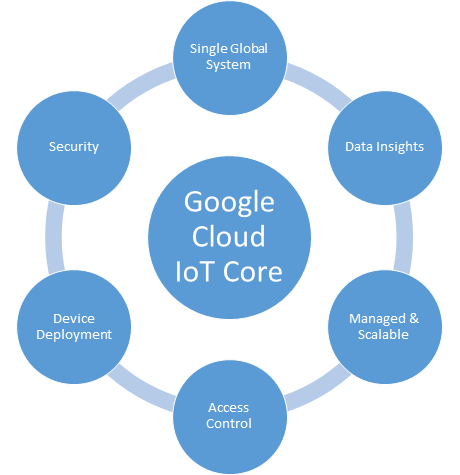
Provide End-to-End Security
It uses asymmetric key authentication and CA-signed certificates to verify device ownership. Devices running Android Things deliver full-stack security.Manage Single Global System
It connects all devices as well as gateways to Google Cloud through MQTT and HTTP protocol endpoints. Thus, it manages all devices as a single global system. It can manage data retention for a week as a short-time backup.Outstanding Data Insights
Google Cloud IoT Core integrates your devices with Google Big Data Analytics and various Machine Learning services, including Dataflow, BigQuery, Bigtable, ML, Data Studio, other partner Business Intelligence tools.Managed & Scalable Service
It is a server-free service, so it doesn’t require the installation of any software upfront. It scaled horizontally instantly without looking for limits and managed automatically.Access Control at Role Level
To control user access to devices and data, it applies IAM roles to registries of devices.Device Deployment
It uses REST API to manage registration, deployment, and operations at scale. When devices are not connected, it also uses API to retrieve and update device properties.Advantages of Google Cloud IoT Core
There are plenty of advantages to listing, but the following are worth considering.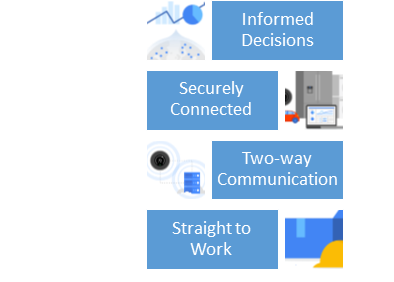
Cloud IoT Core services help to make informed decisions at the global level.
Cloud Pub/Sub aggregates data from the geographically dispersed devices into a single system seamlessly. Using Google Cloud IoT Core services, you can perform analysis, visualize, and implement machine learning to make the right decisions and improve operational efficiencies and build rich models to optimize your business.It helps to establish secure connections to your existing IoT devices.
- Cloud IoT Core allows millions of devices to connect securely through endpoints.
- It uses automatic load balancing & horizontal scaling. It ensures smooth data flow at all times.
- It supports MQTT & HTTP protocols.
- It runs on server-less infrastructure & scales automatically to real-time changes.
- It adheres to strict security protocols & protects business data.
It assists in establishing a two-way connection with IoT devices.
- Google Cloud IoT Core provides a secure, intelligent, and responsive IoT data pipeline to bring device data into everyday business.
- It relies on the intelligence of Android Things.
- It pushes automatic firmware updates or device updates.
It gets you straight to work.
- It helps in managing IoT data networks through a single pane of glass.
- It works with Android Things and other devices from leading hardware manufacturers.
- It helps to cut capital investment on IoT projects by offering pay-as-you-go services.
Google Cloud IoT Core Partners
Despite the stiff competitions from its ultimate rivals Amazon & Microsoft, and its late entry, Google catches on fast and gains a strong foothold in the niche market thanks to its Android alliance and device partners, including: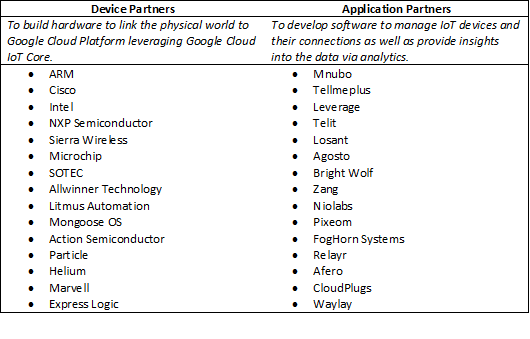 Schlumberger oilfield services and Smart Parking Company in New Zealand are ideal examples of how the industry leverage Google Cloud IoT Core services offerings.
Moreover, Google will acquire LogMeIn’s Xively business unit for $50 million to bring real-time stream processing technologies.
Schlumberger oilfield services and Smart Parking Company in New Zealand are ideal examples of how the industry leverage Google Cloud IoT Core services offerings.
Moreover, Google will acquire LogMeIn’s Xively business unit for $50 million to bring real-time stream processing technologies.
